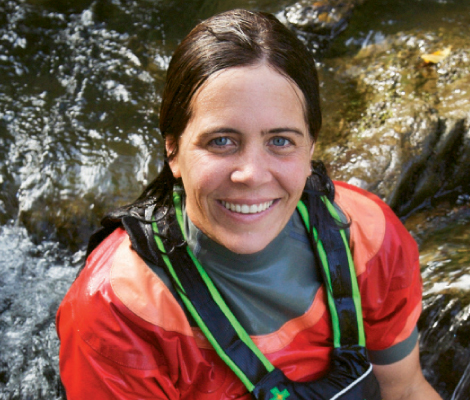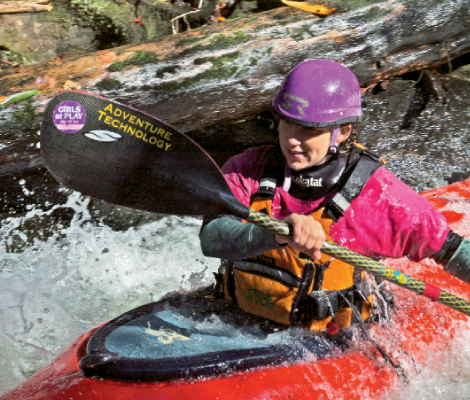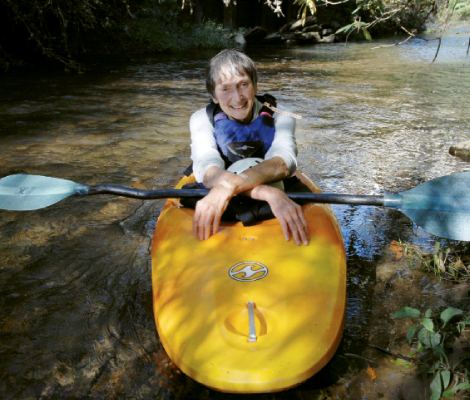The River Maidens
The River Maidens: Ride the waves with WNC’s leading female kayakers
The Naiades of ancient Greece were fresh water spirits—relatives of Poseidon—who presided over rivers and streams. Known for possessing an ethereal grace, they were also tied to their bodies of water, which were essential to their survival.
Like those ancient spirits, Western North Carolina has its own version of river nymphs. You might recognize them by the plastic form attached to their waists; helmets and padded armor worn across their chests; or see them floating and playing in the waves of some of the East Coast’s best white water. Every day, these women ply the same rivers and rapids that draw kayakers from around the country with their otherworldly grace.
Nationwide, women are among kayaking’s fastest growing market. This is an individual sport, yet within that, especially for women, there is a collective energy that can encourage, inspire, and empower.
Part of what attracts women to kayaking has as much to do with the properties of the river as with the sport itself. That means moving with the flow. A kayak works with the river, and the river you ride often dictates the type of experience you’ll have. Female instructors constantly remind their students that you don’t need to be strong to kayak; the sport is all about finesse. It’s a matter of learning to read the water and use the river to help you get to where you want to go. Strength and fitness make it easier, but you’ll build those qualities the more you get out on the waves.
The fact that the region’s rivers and creeks offer varying levels of difficulty makes paddling an easy sport to enter into, and one that keeps people challenged and inspired to achieve mastery. From the accessibility and ease of the Nantahala, to the more technical Class IV-V behemoths like the Cheoah, Green Narrows, and Linville rivers, paddling in WNC is a banquet of white-water treats.
Here is a look at five fabulous women of the river who’ve made that progression from novice to expert—and in many cases, serve as role models and mentors to new boaters. Anna Levesque, Bunny Johns, Adriene Levknecht, Dixie-Marree Prickett, and Juliet Jacobsen-Kastorff can almost always be found paddling one of WNC’s rivers. They’re just a few of the hundreds in this area, from all walks of life, who make time to play in the water as often as they can.

The Drifter : Dixie-Marree Prickett
A self-described southern Belle who likes to get her hands dirty and play outside, Dixie-Marree Prickett moved to Asheville to be an instructor at the Nantahala Outdoor Center. Pyranha Kayaks picked her up as a sponsored athlete, and she spent five years traveling the country in an RV, hopping from river to river. “Every boating company had a team—a traveling gypsy band,” she says. “I got the best of it.” She boated the Americas, Europe, and Asia. Now, she logs her miles as a rep for Patagonia and spends six months of the year on the road. “I still get to travel, but I’m not gone as long. It feels much more balanced.” When home in Asheville, Prickett paddles 15 to 30 days a month—often on the Green River Narrows. “You couldn’t ask for a nicer Class IV-V in your backyard.”
What’s your favorite river & why? › I was just in Tibet. We paddled several different stretches of the Tsang Po and we also ran many other smaller rivers and creeks. My favorite area was the Sum Sum River and valley that leads into the Tsang Po. Po means river in Tibetan. It was so beautiful I couldn’t stop crying. And the Green just feels like home. It’s so special because of the community.
What’s been your favorite moment on the river? › On the Gauley in West Virginia, 2004. During Gauley Weekend they ramped up the water flow after 2 p.m., and Pillow Rapid was at 10,000 cubic feet per second. My friends Katie, Little Dave, and I were in playboats. It was so exciting my ribs hurt from laughing so hard.
When you’re not in the water? › I like to make jewelry. I blow my own glass beads. I also love to cook and garden.
How can new paddlers get started? › Just get in a boat and get out there. I’m seeing more and more people getting out on the rivers and creeks, and not just in kayaks, but in inner tubes and duckies. And there are more and more paddling clubs, many in North Carolina.
Your heroes? › Daniel DeLaVergne. He was a leader in white-water videography. He passed away in 2006. I was lucky to have traveled around the country with him for Pyranha. Daniel was always ready to fire it up and he was a huge motivator for me.
What philosophy do you live by? › “Live well. Love much. Laugh often.” It’s on a wooden plaque that Daniel’s family had made to honor him.
What are your future plans, big dreams? › To do an all-girls, take-Europe-by-storm paddling trip. Then get all the ladies over to Tibet.

Positive Influence: Anna Levesque
The 34-year-old Canadian was a bronze medalist at the 2001 World Freestyle Kayaking Championship and a member of the Canadian National Freestyle team for five years. As a professional white-water kayaker and international guide, she’s worked and paddled in Canada, the U.S., Costa Rica, Chile, Ecuador, Mexico, New Zealand, Spain, France, Australia, Austria, and Africa. Building on her experiences, Levesque developed Girls at Play, a local company dedicated to increasing the number of females in kayaking by using the sport as an empowering experience for students.
What’s your favorite moment on the river? › It’s that time when I’m above a really challenging rapid and I decide to go for it. From that moment on there’s no turning back, and all my focus and attention come to the present. It’s very intense and exciting.
What principle or motto do you live by? › I am connected to everything around me so my every action, thought, and word affects everything around me, too. It’s important for me to take responsibility for my actions because how I treat my neighbors, my family, my community, and the environment is also how I
treat myself.
Do you see any differences between how men and women approach boating? › The biggest thing I’ve seen during my years of teaching is that men are much more physically aggressive and they tend to have more confidence right from the beginning, especially when trying new things. On the other hand, women have a tendency to worry about being the weak link in the group and often lack confidence in themselves. I love teaching kayaking and combining paddling with yoga because I get to witness women becoming empowered and learning to trust themselves through the experience. White-water paddling is very transformative for many women.
What are your plans for the future? › My dream is to continue to facilitate women’s kayaking and yoga retreats and classes here, in Mexico, and around the world. Eventually, I would love to have my own adventure retreat center here in Western North Carolina.

Leading Lady: Bunny Johns
From instructor, to competitor, to community leader, Elizabeth “Bunny” Johns is something of the grande dame of paddling in WNC. Originally from Atlanta, she was part of the early Nantahala Gorge paddling community, first coming to the area as a counselor at Camp Merrie-Woode for girls in Sapphire in the early 1960s. In fact, it was there that she was introduced to paddling. She taught swimming at camp, and her students, in turn, taught her to paddle the lake in a canoe. Soon, she graduated from paddling lakes to white water, and learned to navigate Section III of the Chattooga River.
She took the plunge and moved to Bryson City to work as a manager at the kayak school. “At that time, the philosophy was that everybody did everything: clean rooms, kayak and raft guide, cook. After I burned the trout, they got me out of the kitchen,” she laughs.
Part of a group of serious paddlers, she began racing open-boat canoes on the national level. In 1981, she and Mike Hipsher earned the gold medal at the Wildwater Championships in Bala, Wales. She was president of Nantahala Outdoor Center from 1991 to 2000. She even served on the Olympic Committee that helped bring the summer Olympics to Atlanta in 1996.
Today, she applies her energy to improving our area. Bunny earned a doctorate in plant physiology from N.C. State University, allowing her to work with Duke Energy to rebalance its use of resources. And she works with the Little Tennessee Land Trust, helping to conserve the landscape of the upper Little Tennessee and Hiwassee river valleys—saving the waterways she came to love so many years ago.

The Ingénue: Adriene Levknecht
At 22 years old, this Michigan transplant has already made a big impact in the kayaking community. A former competitive gymnast and swimmer, she’s been described as fearless with an unyielding energy. With 10 years of paddling experience, she made the U.S. Freestyle Team in 2009, and that same year competed at the World Freestyle Kayaking Championship in Switzerland, and placed first in her division at the Green River Race (clocking the best time for a female in the race’s history). — Kate Mackay
What’s your favorite river and why? › The Green River in Saluda. The atmosphere and sense of family on this river is like nowhere else. The paddlers range from people who can handle Class IV and just want to see the Green to some of the best paddlers in the world. The Green is ever-changing and people mold their lives around this river. Not many rivers are like that.
What’s your favorite moment on the river? › When I get the falling sensation—going fast and falling, like on the Toxaway by Cashiers. There are lots of big drops and really big slides.
Your heroes? › My mom is my biggest hero. She’s just an amazing woman and has overcome a lot to be where she is now. She never gives up on me either, no matter how much I screw up. Also kayaker Tanya Faux has helped me out a lot in the paddling world, she’s just a very genuine woman.
Do you notice any differences between how men and women approach boating? › Yes. Women have a harder time letting their past go and visualizing the future. We wrap our heads around things that have already happened that we can’t change. I know a lot of guys who just charge and figure it out as they go. I’ve gotten better at that as I’ve followed those guys down rivers for the last three years. It’s all about living in the moment.
What are your plans for the future? › I’m going back to school to become a medic. I would also like to dominate the Teva Mountain games and take a spring trip to California with the girls. I want to be able to play a larger part in the kayaking community other than just being a good kayaker. I want to be an all around good person also.

The Teacher: Juliet Jacobsen-Kastorff
At one time Jacobsen-Kastorff was a textbook Washington, D.C. overachiever—studying for a master’s at Johns Hopkins University, waiting tables, and serving as a program coordinator for the nonprofit American Society for Microbiology.
In what little free time she had, the former Texan started paddling with a group of local boaters who rode the Potomac. “The CIA had lots of paddlers. No chatting, though,” she says. “When I started kayaking, it was the first time I did anything I wanted to be great at.” It was an experience that would take her from student to teacher.
After witnessing a more relaxed lifestyle during a trip to the Nantahala Outdoors Center, “I realized pretty quickly it was time for a career change. I was working on my master’s so I could teach English, but I decided it was time for me to see what it was like to live here. Instead of going to school and working two jobs, I continued my studies at Western Carolina University and waited tables at NOC.” Along the way, she met Ken Kastorff, who was developing a reputation in his field. “Ken was one of the most amazing instructors I’d ever met. I told him we should start a company.”
She and Ken bought Endless River Adventures in 1993. “Ken flat out told me I wasn’t good enough to teach, so I went out for two years and learned from the best teachers,” she says. “I learned how to read rivers. I learned how to roll. I learned that rivers weren’t there waiting to beat you up.”
Today, she and Ken, who is now her husband, operate one of the area’s most respected kayak instruction programs. When they’re done guiding on the Nantahala, Ocoee, and Cheoah during the summer, they lead expeditions in Costa Rica and Ecuador in the winter. “Now, I get to teach all the time. The whole goal is to make somebody better than you.”
